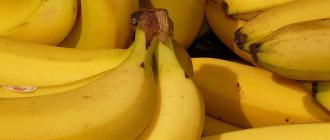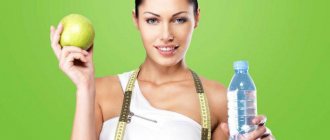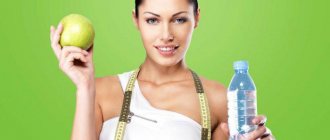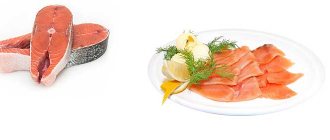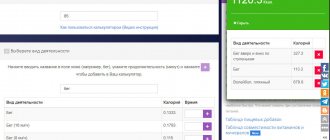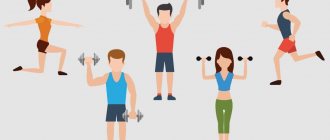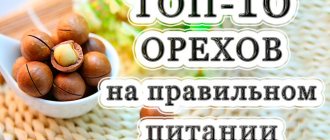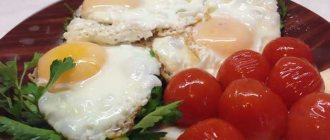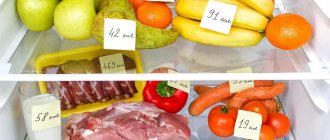When planning a diet, those losing weight are interested in how many calories are in a banana and whether it is possible to gain weight if you eat the fruit daily. Bananas are tasty, healthy and nutritious, and contain almost no fat. Bananas are low in calories - they are a dietary product. However, the main component of the fruit is carbohydrates, so if the diet is planned incorrectly, eating bananas can cause you to gain weight.
What are the benefits of banana?
Banana is versatile in cooking. Oatmeal with a banana and half an apple for breakfast, a banana smoothie for an afternoon snack, cottage cheese with a banana for dinner, a milkshake for dessert and chips if you really want something sweet - such a varied menu can be created from just one fruit. This diet will please any sweet tooth.
Bananas are also very beneficial for the body. The composition of the fruit contains many B vitamins, minerals and trace elements:
- Vitamin B3 or nicotinic acid is involved in the processes of cellular respiration, thanks to which proper metabolism of proteins and fats occurs. It regulates the amount of cholesterol in the body, preventing it from rising.
- Vitamin B5 or pantothenic acid is involved in carbohydrate metabolism. Improves microcirculation of blood vessels, produces histamine and hemoglobin.
- Vitamin B6 or pyridoxine – is involved in the synthesis of serotonin and adrenaline. Its function is to maintain the skin, teeth and gums in a healthy condition.
- Potassium regulates the proper functioning of the nervous system. Positively affects the functioning of the heart and blood vessels of the brain. Normalizes blood pressure, reduces the risk of stroke. Deficiency of this element causes kidney failure, increases blood pressure, and the appearance of cellulite.
- Magnesium supports the rhythmic functioning of the heart. Reduces muscle tension and reduces blood clotting. Without it, calcium and potassium are not absorbed.
- Sodium fights swelling and has a diuretic effect. A large amount of it is found in unripe green fruits.
The composition of the fruit also includes dietary fiber, pectin, enzymes and tannins that cleanse the body of waste and toxins. Daily consumption of fruit can reduce fatigue, increase performance and concentration.
Athletes, especially heavyweights, have a slightly different problem. Sometimes they need to gain weight to meet the standards. Therefore, bodybuilders use this product to gain muscle mass. Therefore, this is a favorite delicacy for athletes; they also have their own sports diet.
Meals, vitamin cocktails, yogurt and banana smoothies become part of the diet of people with diseases of the cardiovascular system and bronchopulmonary spasm.
The banana diet is alkaline, so it can treat diseases of the gastrointestinal tract and liver. Constant consumption of fruit helps to normalize the water-salt balance. And the composition of the peel is used in folk medicine to treat many diseases.
- Interesting read: fasting day on bananas
The path from the tropics to our table
One of the most interesting and mysterious issues that interest the minds of Russian people is the low cost of bananas lying on the shelves of our stores. It is very close to the cost of domestic apples. And this despite the fact that bananas have to travel thousands of kilometers from their place of growth to our borders.
The secret of such a low cost of bananas is their high yield - up to 400 centners per hectare. For comparison: the yield of the most modern potato varieties ranges from 400 to 800 centners per hectare. Although in most farms and collective farms this figure is much lower.
Bananas begin to be harvested when they reach approximately 75 percent ripeness. After which they are promptly delivered to refrigerators, in which they reach the borders of our country at a temperature of +13-15 °C. Next, the bananas are stored in wholesale warehouses, where at a certain point they are treated with a special gas (nitrogen + ethylene). As a result, the ripening process starts in bananas - starch turns into simple sugars, the color of the fruit changes. Further ripening occurs within 3-7 days.
From now on, bananas can be eaten.
After purchasing, bananas should be stored under normal conditions: at room temperature, in a dark place. Don't put bananas in the refrigerator! Because when they get into the refrigerator, they begin to deteriorate (rot). And this will happen faster than at +25-30 °C. The ideal temperature for storage is the same +13-15 °C.
Compound
Banana pulp and even peel contain a large amount of nutrients, vitamins and microelements.
Nutrient content table
| Substance | Gy per 100 g of product |
| Squirrels | 1,5 |
| Fats | 0,1 |
| Carbohydrates | 21,8 |
| Water | 74 |
| Starch | 2 |
| Cellulose | 0,8 |
| Ash substances | 0,9 |
| Iron | 0,06 |
| Potassium | 0,284 |
| Calcium | 0,8 |
| Sodium | 0,42 |
| Vitamin B3 | 0,012 |
| Vitamin B5 | 0,04 |
| Vitamin B6 | 0,05 |
| Vitamin C | 0,1 |
| Folic acid | 0,1 |
| Vitamin E | 0,4 |
A little history
Banana is one of the oldest cultivated plants. Drawings discovered on the walls of ancient buildings indicate that the Egyptians bred a huge variety of varieties on plantations. The people of New Guinea grew them even earlier. And the first written mentions are found in ancient Indian epics, which date back to the 5th-6th centuries BC.
Archaeologists claim that domestication occurred 10,000 BC. e. Cultivated plants then spread to Southeast Asia and Africa. In the 16th century, Portuguese sailors brought bananas to the American continent. But Europeans tried them only at the beginning of the 20th century. It was difficult to transport perishable goods by sea without refrigerators.
Calorie content per 100 grams
On average, one large banana without peel weighs 100 grams. The calories in it are calculated per 100 grams, also without peel. The energy value is 85-100 calories per 100 g. This product is consumed during diets, but in rather limited quantities. Bananas contain starch, which contributes to the formation of excess weight. They can perfectly satisfy hunger, and the feeling of fullness lasts for a long time. Therefore, it is a great snack while dieting.
Bananas come in different types and vary in degree of ripeness. Because of this, their energy value varies within certain limits.
Fresh
The calorie content of a small or medium-sized banana will be in the range of 75-95 kcal. The calorie content of a fresh large banana without peel is 100 kcal.
Greens
The calorie content of an unripe banana is about 110 kcal. This is due to the fact that it contains more fiber and starch, as well as unsaturated fatty acids.
Mini
Mini bananas are small fruits. They are the smallest and sweetest of all species. The average weight of a mini banana is 80 grams and their calorie content is 80 calories.
Dried
Dried banana chips are a common delicacy. Included in various nut mixtures, an additional component in muesli. 100 grams contain 300 calories. Quite a high-calorie, but at the same time healthy product.
Diet dishes
Regular and mini bananas have a distinct sweet taste, so those with a sweet tooth who are watching their figure will love it. They go well with cottage cheese, yogurt, and kefir. To maintain your figure in perfect condition, or if you want to lose a couple of extra pounds, you can replace one meal with several bananas.
There are many dietary recipes based on it. These include various vitamin cocktails, smoothies, juices and herbal teas. For example, 100 grams of banana juice contains 85 calories. Regular bread can be replaced with banana bread; its energy value is 320 calories per 100 grams.
Banana is the main component of mono diets. It is mixed with milk or kefir. The calorie content of such dishes does not exceed 150 calories.
Harmful candies and high-calorie sweets can be replaced with dried fruits, but they should be consumed in moderation. Banana chips contain almost three times more sugar and calories.
table for banana dishes:
| Product or dish | Kcal per 100 grams of product |
| Medium sized fruit | 85 |
| Large fruit | 100 |
| Mini fruit | 80 |
| One kg of bananas | 8500-1000 |
| Overripe fruit | 117 |
| Dried fruit | 300 |
| Cottage cheese with banana | 190 |
| Oatmeal with banana | 62 |
| Banana milkshake | 120 |
| Banana smoothie | 154 |
| Banana with kefir | 59 |
| Banana chips | Over 500 |
| Fried fruit | 205 |
| Banana yogurt | 136 |
| Banana cupcake | 225 |
| Salad with bananas and apples | 150 |
| Banana toast | 239 |
| Banana milk | 110 |
Banana peel: benefit or harm?
Slipping on a banana peel is the biggest harm it can cause. Banana peels are not poisonous and are in fact full of nutrients and are edible. According to Flores, “In many parts of the world, banana peels are used for cooking, although this is not common in the West. It contains high amounts of vitamins B6 and B12, magnesium, calcium, fiber and protein.” An article was published in the journal Applied Biochemistry and Biotechnology in 2011, according to which banana peels, among other things, contain “various biologically active compounds, such as polyphenols, carotenoids and others.”
Before eating banana peels, you should wash them thoroughly, as various pesticides are often sprayed in banana groves.
Typically, banana peels are served cooked—boiled or fried—but are sometimes eaten raw or added to a blender with other fruits. It doesn't taste as sweet as the banana itself. The skin of the ripe fruit may be sweeter than the green skin.
When not to eat bananas
Regardless of how many calories are in a particular type of banana, in some cases you should not eat it at all:
- It is a sweet fruit and contains a large amount of sugar, so it should not be consumed by people suffering from diabetes.
- Overweight people are advised to exclude this product from their diet.
- Stale, poor quality and spoiled fruits can harm the liver.
- Bananas take a long time to digest, so you can eat them in small quantities.
- They are contraindicated for people with varicose veins and thrombophlebitis.
- The fruit thickens the blood, increasing the risk of thrombosis.
A banana does not contain many calories, so why do many people gain weight and gain weight by eating such a dietary fruit? It's all about the carbohydrates. When planning a diet, you need to take into account the carbohydrate base of the banana and adjust the rest of the diet so that the balance of proteins - fats - carbohydrates is not disturbed.
If you devote the bulk of your diet to banana dishes, then the rest of your diet should consist mainly of protein.
In this case, the fat component of the menu is given third place. For the diet to be effective, you need to organize your meals in accordance with your daily calorie intake, and also calculate how much protein, fat and carbohydrates should be on your plate every day.
THESE ARTICLES WILL HELP YOU LOSE WEIGHT
Other plant compounds
Fruits and vegetables contain numerous types of bioactive plant compounds, and bananas are no exception.
- Dopamine : Is an important neurotransmitter produced in the human brain. However, it is worth understanding that the dopamine present in bananas does not cross the blood-brain barrier to influence mood, but rather acts as a powerful antioxidant (7).
- Catechin : Several antioxidant flavonoids are found in bananas, especially catechins (8). Catechins have been shown to provide a variety of benefits to the human body, including reducing the risk of cardiovascular disease (9).
Summary:
Like other fruits, bananas contain several health-promoting antioxidants that are associated with many health benefits. These include dopamine and catechin.
Characteristics of the fruit
The fruit, rich in important substances, has an oblong semicircular appearance, with a pointed tip of smaller diameter than the fruit itself. Elongated ribs run along its entire length, smoothing out according to the degree of maturity. Banana peel is dense and its thickness partly depends on the variety of the fruit. The nutritious part of a banana is the pulp, which, when fully ripe, is equal to 75% of the total weight of the fruit.
The unripe fruit is distinguished by its color, as well as its distinctive appearance. The unripe delicacy has a greenish rind color that adheres tightly to the pulp. In turn, the pulp has a hard appearance and breaks when folded.
A ripe fruit, depending on the variety, contains around 20% starch by weight and fructose instead of sugar. It is distinguished by its unique aroma and is divided into group chemical composition - “dessert” and “planktein”.
How to use correctly and in what quantities
To get the maximum benefit from the fruit and become a “banana guru”, you need to follow a few tips:
- The main and main problem is that there is no need to get rid of the white threads (phloem). They are a great source of fiber and potassium. Unlike pulp, the content of vitamins in them (A, B6) is noticeably higher.
- If at home a banana is usually held in the hands when eating, then in public places cutlery is used: a knife and a fork.
- The fruit is consumed before the main meal, as an independent dish, and after meals, as a dessert.
- At night, you can eat the fruit only half an hour before going to bed.
- Nutritionists recommend eating bananas before lunch break. The body is saturated with the energy it needs to tone.
If one day you eat a kilogram of bananas in one sitting, it will not make a person worse. But before consuming the fruit systematically, you should first of all consult with specialists. An excess of useful minerals is also not desirable and nothing good will come from it.
There are several other reasons that determine the rate of fruit consumption:
- Banana is a heavy product for the digestive system. It takes a long time (about 4 hours) to digest.
- High calorie content of fruits.
- Scientists have found that exceeding the daily norm by more than 3 pieces can affect the appearance of systematic headaches. It is affected by excess tyramine.
- It depends on the individuality of the body, but it has been noted that an excess of fruit in the diet can provoke a laxative effect.
Note: In the homeland of the fruit, residents do not exceed a daily ration of more than 3 pieces.
Diet for weight loss
And yet you can lose weight with this fruit. And usually, they choose one of two options.
Express method for 3 days, allowing you to lose 2-3 kg. Throughout the diet, the daily ration consists of 1-1.5 kg of ripe dessert bananas and 1.5-2 liters of water and green tea. Plus, as a one-time snack you can have a piece of boiled chicken (50 g) or oatmeal porridge with water (4-5 tbsp.).
A week-long banana diet, the results of which can reveal a loss of 5 kg, assumes the same norms of drink and fruit, but supplemented with the following products, allowing you to eat up to six times a day:
- 4 rye bread toasts (without butter, of course);
- low-fat cottage cheese (100 g);
- boiled/stewed vegetables - broccoli, green beans, pumpkin (150 g);
- 1 boiled chicken egg (or 3-4 quail);
- steamed fish fillet (without fat) (100 g).
